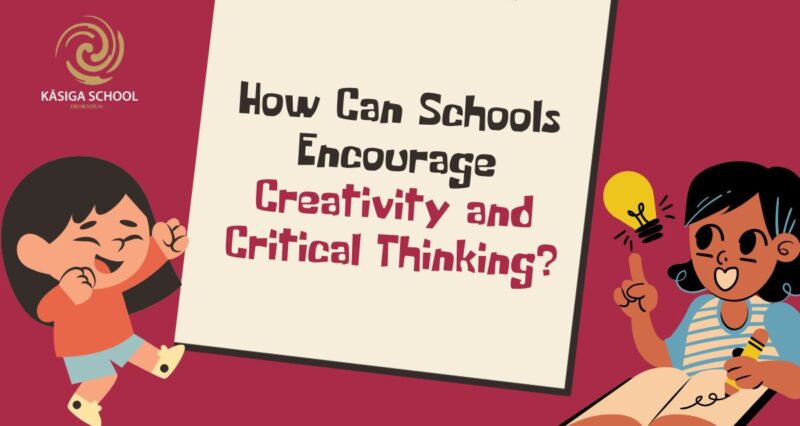As the world keeps changing rapidly students need critical thinking ability together with creativity to achieve success academically and professionally today. The role of schools is paramount because they create fertile learning spaces that support students to research their concepts while testing established rules and developing new ones.
Educational institutions that prioritize these approaches will graduate students who excel both in current academic demands and develop enduring capacities that will last throughout their personal and professional development.
This post examines step-by-step approaches that educational institutions can adopt for developing crucial competencies in their student body.
Understanding Creativity and Critical Thinking
The definition of creativity and critical thinking must be clarified before discussing methods for their development.
- A person demonstrates creativity through their production of innovative solutions and fresh ideas and alternative ways to solve problems. To be creative means both generating original ideas and developing multiple ways to assess situations.
- The process of analyzing information through evidence evaluation leads people to formulate reasoned conclusions which makes up critical thinking. A person uses careful decision-making along with fact-based reasoning to challenge existing assumptions.
Creative thinking combined with critical thinking forms a complete system because a thinking attitude toward innovation helps develop practical solutions.
Strategies for Encouraging Creativity and Critical Thinking in Schools
Create a Supportive Environment
The development of creativity depends on schools establishing environments that support experimental and risk-taking approaches. The following steps can help build such an environment:
- Foster Creativity: School events dedicated to showcasing student projects should be held frequently to celebrate creative achievements. High recognition and celebration of creative work helps schools establish innovative thinking as essential.
- Emphasize Process Over Product: Students should concentrate on their creative development instead of directing their attention to the finished project. The space to make errors will produce innovative findings together with new solutions.
Integrate Project-Based Learning
Students learn both creative skills and analytical abilities under Project-Based Learning because they get to solve real-world problems:
- Team Collaboration: Group collaboration allows students to exchange multiple ideas together as they work alongside their peers. Students generate new ideas and develop solutions through their joint efforts during collaborative sessions.
- Problem-Solving: Students learn practical problem-solving through handling complex issues so they can evaluate solutions while applying analytical skills to real-world problems.
Encourage Open Dialogue and Questions
Open discussion areas in educational settings develop critical thinking abilities because through conversation students learn to think critically. Schools can implement:
- Socratic Seminars: Learning occurs through open discussions in seminars which allow students to ask many questions with mutual respect for differing viewpoints.
- Feedback Culture: Encourage constructive feedback among peers. Students who learn to understand multiple viewpoints develop better critical thinking abilities and become more open-minded.
Incorporate Arts and Humanities in the Curriculum
Using arts along with humanities within standard academic programs enables outstanding advancement of creative abilities and analytical skills. The subjects which include music and theater, visual arts, and literature provide students with platforms to develop self-expression and original thinking. These include:
- Interdisciplinary Projects: Collaborating on projects that combine various subjects can generate imagination. Students, for instance, can study history and then apply it to create art or performances according to the period.
- Creative Writing Exercises: Students have to undergo creative writing exercises wherein they create stories and hear poetry. This makes them develop imagination by experimenting with various types of stories and ideas to write.
Diverse Learning Opportunities
Excellent academic development emerges when students participate in multiple learning activities. Schools can:
- Extracurricular Activities: Educational clubs should organize art-based and tech-oriented as well as innovation-driven events. The assorted extracurricular choices enable students to discover their interests since they operate in spaces designed for creative education.
- Guest Speakers and Workshops: The school should invite professionals to lead workshops that allow them to share their practical experiences with students. Students encounter true-life experiences that lead them to discover creative solutions and evaluate professional opportunities.
Use Technology Wisely
Modern technology proves itself as an excellent resource that helps educators develop creative potential while teaching effective thinking skills. Schools can utilize:
- Collaborative Tools: Educational platforms including Google Workspace along with Microsoft Teams provide students with collaborative tools for working together on projects and exchanging ideas and feedback.
- Creative Apps and Software: Schools should implement design tools and coding platforms alongside multimedia applications to enable students to develop both technological expertise and their creative abilities simultaneously.
Conclusion
Developing creativity skills and critical thinking in schools holds a major importance for education. Educational institutions can develop students’ essential future skills through supportive learning environments combined with dialogue promotion and arts integration alongside diverse education methods and technological access. Kasiga School devotes itself to creating an energetic educational space that trains students to solve innovative problems while exhibiting analytical thinking skills for their future roles as creative problem solvers.
The mission of Kasiga School is to develop creative thought processes and critical thinking abilities in all its students. A balanced curriculum combined with whole-student-focused education at the school cultivates necessary competencies that students need to succeed in their future lives. The educational approach at Kasiga School develops students who will overcome contemporary world challenges while remaining both confident and creative.

